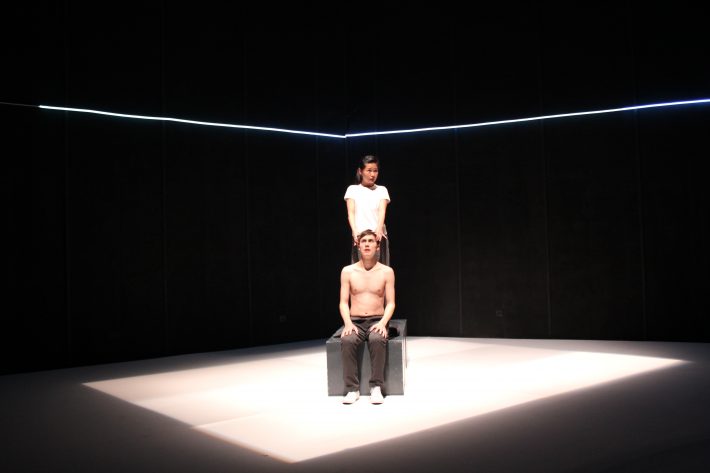Avant-Garde is referred to as an unorthodox and radical creative activity.
For us, this expression was what encapsulated The Transition Room. From embracing minimalism for the set and costumes to the largely non-narrative approach of storytelling, The Transition Room sought to incite a new theatre experience in Singapore, and as audience members, we felt this motivation from the get-go…
Seated in close proximity to the set which resembled a bare and abstract room, the tone for the audience’s’ relationship with the impending story was set to be an immersive one from the start. Such an arrangement, which was unlike any theatre experience ArtJam had encountered thus far, reminded us that (as theatergoers) the themes explored in theatre are very much relevant and close to everyone.
Opening with Mike (Christer Aplin) as the protagonist and three other characters who were stuck in a room with no memory or knowledge of what they were waiting for, it was clear that this was a homage to both Samuel Beckett’s Waiting For Godot and Jean-Paul Sartre’s Huis Clos (No Exit). As the play explored the ideas of purgatory, existentialism and the essence of the Absurdist movement, the team cleverly experimented with abstraction — by often pushing for and then abruptly pulling away from the abstract. Doing so not only enhanced the uncertainty of the story but also helped the audience resolve the open-endedness of the play while still leaving enough room for the audience to formulate their own conclusions. Though much of the play was meant to be led by thoughts rather than a narrative sequence, using Mike as the protagonist to chart the story helped to guide an amateur audience to connect the dots as he explores each room which presented itself with unprecedented rules and characters.
Masterfully using its set, which were made up of simple elements, the team was able to depict multiple situations that the characters find themselves in. Without the use of a crew to shift the props, 4 simple black boxes were personally moved around by the cast and placed differently to form seats in a waiting room. Yet, in another scene, the same 4 chairs were used to form a massage table to depict an eerily familiar situation. After all, we all get massages, don’t we? Furthermore, the use of lighting played an important role in creating a sense of chaos as the audience constantly feel like they are forced to adapt to how each scene looks before even understanding the previous one. At one point, the lights were strobed repeatedly as the cast spoke over one another, whispering indiscernible questions. Along with the seemingly absurd lines that each character spoke, such lighting cues contributed to our growing sense of unease as the play progressed.
Nonetheless, we were impressed by the versatility of each cast member who took on multiple roles throughout the play. Despite making only minor changes to their costumes, the cast members were able to portray a completely different personality once they switched into another character. For example, Tan Hui Er plays the naive, newest member of the waiting room that the protagonist Mike, finds himself in at the start of the play. In a later scene, she faces Mike again, but as a different character– a seemingly robotic masseuse who becomes increasingly eerie as she questions their existence. The fact that she was able to portray two completely different characters with minor changes to her costume and no changes to her make up at all is a true testament of her acting talent. Ultimately, the cast delivered compelling performances, fully embodying the mystery the script was supposed to deliver.
As audience members, we left the play no less confused than we were in the middle of it. But I guess that was the point: to invite the audience to question everything they’ve come to understand as the reality of the world and of themselves. We can’t claim to have completely understood the play, but we did thoroughly enjoy having our brains tickled in the duration of the play. Having been fully intrigued by The Transition Room, we look forward to Toy Factory’s next production!
Written by Jodie Lim and Claris Likin


